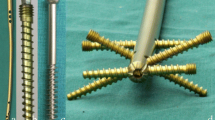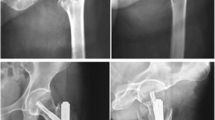Abstract
Background
Intramedullary fixation is the treatment of choice for diaphyseal fractures of the femur and tibia. Locking the implant can sometimes be cumbersome and time consuming. In our institution, fractures with axial and rotational stability are treated with intramedullary nailing without interlocking.
Methods
All consecutive patients presented in the University Medical Center Utrecht from October 2003 to August 2009 with acute traumatic diaphyseal fractures of the tibia or femur that were considered axial and rotational stable were included. They underwent internal fixation using intramedullary nails without interlocking. Patient records were evaluated for duration of surgery, perioperative complications, consolidation time and re-operations.
Results
Twenty-nine long bone fractures were treated in 27 patients: 20 men and 7 women, with an average age of 28.9 years (range 15.6–54.4). There were 12 femoral fractures and 17 tibial fractures. Sixteen fractures were closed and 13 were open (10 Gustilo 1, 3 Gustilo 2). The mean operating time was 43 min (range 18–68 min) for tibial fractures and 55 min (range 47–150 min) for femoral fractures. Postoperative complications occurred in six patients. Two patients (three fractures) were lost to follow-up. Healing occurred in 25 of the 26 remaining fractures (96 %) without additional interventions. One tibia was secondarily converted to a standard locked nail because of axial and rotational instability. All patients returned to their pre-injury level of activity.
Conclusion
The use of intramedullary nailing without interlocking is associated with minimal complications in selected fractures. The advantages include a short operating time and the simplicity of its application.

Similar content being viewed by others
References
Duan X, Li T, Mohammed AQ, Xiang Z (2011) Reamed intramedullary nailing versus unreamed intramedullary nailing for shaft fracture of femur: a systematic literature review. Arch Orthop Trauma Surg 131:1445–1452
Duan X, Al-Qwbani M, Zeng Y, Zhang W, Xiang Z ((2012)) Intramedullary nailing for tibial shaft fractures in adults. Cochrane Database Syst Rev 1:CD008241
Lam SW, Teraa M, Leenen LP, van der Heijden GJ (2010) Systematic review shows lowered risk of nonunion after reamed nailing in patients with closed tibial shaft fractures. Injury 41:671–675
Whatling GM, Nokes LD (2006) Literature review of current techniques for the insertion of distal screws into intramedullary locking nails. Injury 37:109–119
Levin PE, Schoen RW, Browner BD (1987) Radiation exposure to the surgeon during closed interlocking intramedullary nailing. J Bone Joint Surg Am 69:761–766
Roux A, Bronsard N, Blanchet N, de Peretti F (2011) Can fluoroscopy radiation exposure be measured in minimally invasive trauma surgery? Orthop Traumatol Surg Res 97:662–667
Koval KJ, Clapper MF, Brumback RJ, Ellison PS Jr, Poka A, Bathon GH, Burgess AR (1991) Complications of reamed intramedullary nailing of the tibia. J Orthop Trauma 5:184–189
Wiss DA, Stetson WB (1995) Unstable fractures of the tibia treated with a reamed intramedullary interlocking nail. Clin Orthop Relat Res 315:56–63
Hems TE, Jones BG (2005) Peroneal nerve damage associated with the proximal locking screws of the AIM tibial nail. Injury 36:651–654
Drosos GI, Stavropoulos NI, Kazakos KI (2007) Peroneal nerve damage by oblique proximal locking screw in tibial fracture nailing: a new emerging complication? Arch Orthop Trauma Surg 127:449–451
Müller ME, Nazarian S, Koch P, Schatzker J, Heim U (1990) The comprehensive classification of fractures of long bones. Springer, Berlin
Gustilo RB, Anderson JT (1976) Prevention of infection in the treatment of one thousand and twenty-five open fractures of long bones: retrospective and prospective analyses. J Bone Joint Surg Am 58:453–458
Lee YS, Lo TY, Huang HL (2008) Intramedullary fixation of tibial shaft fractures: a comparison of the unlocked and interlocked nail. Int Orthop 32:69–74
Lepore L, Lepore S, Maffulli N (2003) Intramedullary nailing of the femur with an inflatable self-locking nail: comparison with locked nailing. J Orthop Sci 8:796–801
Soto-Hall R, McCloy NP (1951) Problems in intramedullary nailing of femoral fractures. Calif Med 74:424–428
Velazco A, Whitesides TE Jr, Fleming LL (1981) Fractures of the tibia treated with Lottes nail fixation. South Med J 74:427–431
Velazco A, Whitesides TE, Fleming LL (1983) Open fractures of the tibia treated with the Lottes nail. J Bone Joint Surg Am 65:879–885
Conflict of interest
The authors declare that they have no conflict of interest.
Author information
Authors and Affiliations
Corresponding author
Rights and permissions
About this article
Cite this article
Kreb, D.L., Blokhuis, T.J., van Wessem, K.J.P. et al. Intramedullary nailing without interlocking screws for femoral and tibial shaft fractures. Arch Orthop Trauma Surg 133, 1109–1113 (2013). https://doi.org/10.1007/s00402-013-1775-9
Received:
Published:
Issue Date:
DOI: https://doi.org/10.1007/s00402-013-1775-9




